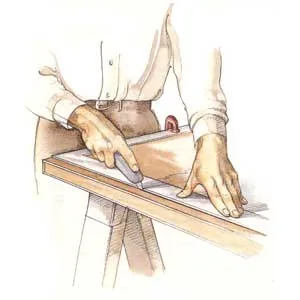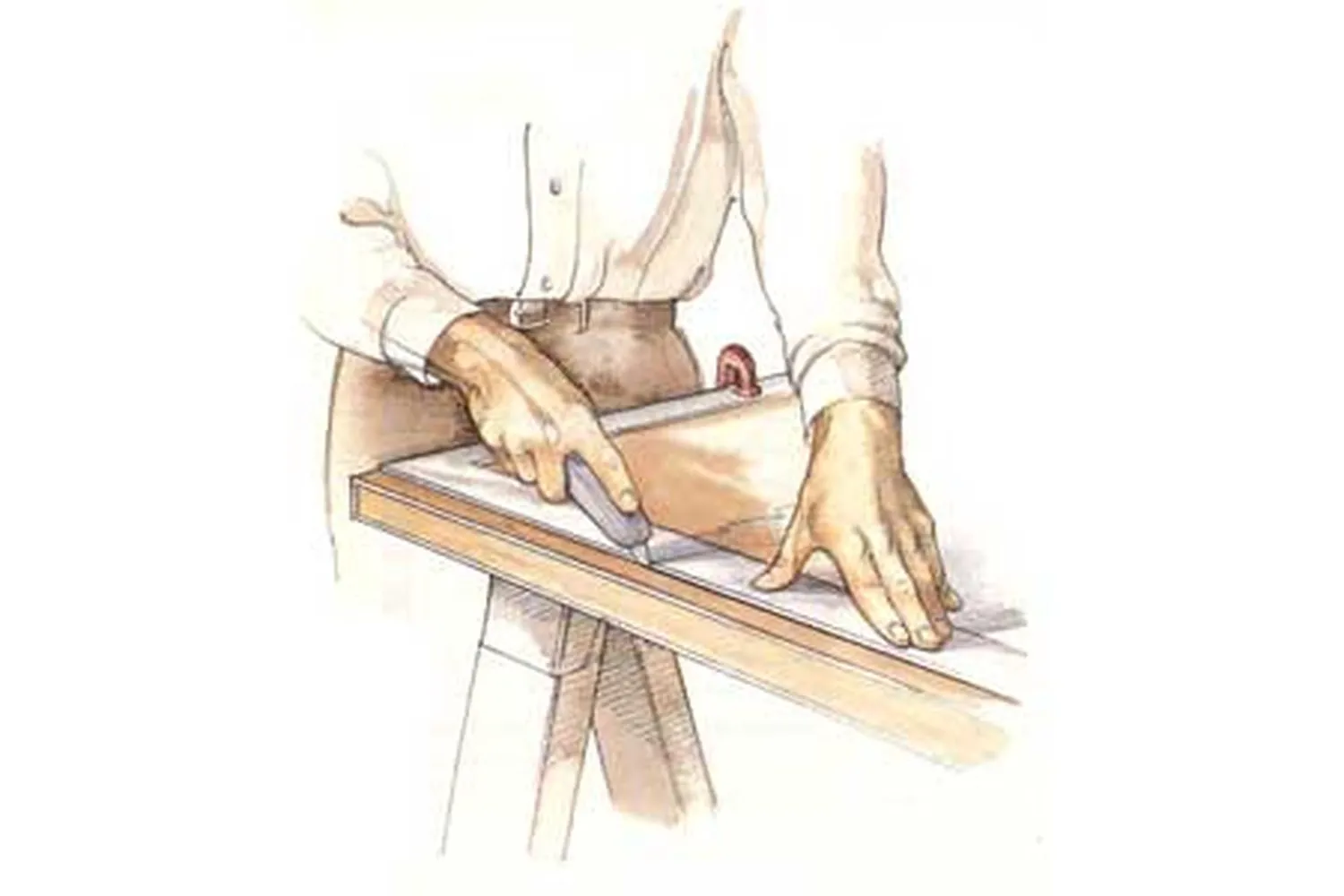

Learning how to saw wood cleanly is an important skill for any homeowner, as splintering can wreck your work and even pose safety risks. The no-splinter sawing process requires just a few tools, a secure work area, and observance of the steps below. Read our guide on how to safely and correctly saw below.
Why Does Wood Splinter?
Wood splintering occurs when a saw’s blade tears wood’s fibers instead of cutting through them cleanly. This can happen if you cut across the wood grain, which is a common consequence of projects such as trimming doors. Splintering is more likely to happen when you’re working with veneered doors, which feature thin outer layers that can easily tear.
Essential Tools for Splinter-Free Sawing
Collect the tools below for a splinter-free cut.
- Circular Saw
- Claims
- Masking Tape
- Sanding Block
- Safety gear, including gloves and goggles
- Straightedge
- Utility Knives
Prep Your Work Area
Follow the steps below to set up your space and keep yourself safe while you work on a door.
Secure the Door
Lay the door flat on a stable surface such as a sawhorse or a sturdy workbench. Support the door and keep it level to prevent any movement while you’re working. If you’re working with a hollow-core door, avoid applying too much pressure, which can cause the door to collapse or crack. Use padding under the door to protect the surface and keep it stable.
Set Up Your Guides
Use a straightedge to measure and mark your cut line carefully. Clamp your metal straightedge along this line to serve as a guide for scoring with the utility knife. Once you’re done scoring, you’ll replace this with a wider board to guide your circular saw.
Step-by-Step No-Splinter Sawing Technique
Follow the steps below to get a clean, splinter-free cut on your door.
Step 1: Apply Masking Tape
Stretch a strip of 2-inch-wide masking tape across the door so that it covers the area you plan to cut. This will support the wood fibers while you cut and keep the door from splintering.
Step 2: Score the Cut Line
Clamp your metal straightedge in place, and use your utility knife to score along the cut line. This will help you to cleanly sever the wood fibers before you begin sawing. Make several firm passes that go through the tape and into the door’s surface.
Step 3: Position the Saw Guide
Remove the metal straightedge, but leave the masking tape in place. Clamp a straight one-by-four or one-by-six to the door to serve as your saw guide. The saw should cut about 1/32 inch to the waste side of your scored line.
Step 4: Make the Cut
Slowly guide your circular saw along the board to trim the door. Press the saw’s base plate against the guide board throughout the cut for a straight, even result. Don’t rush this step, or you could end up with uneven cuts. Practice this technique on scrap wood until you’re confident enough to cut the door.
Tips for Different Door Types
Cater your cutting technique to the project at hand and the type of material you’re working with.
Solid Wood Doors
Solid wood is difficult to damage, but it can still splinter. Use a blade that has more teeth than other types for a smoother cut.
Veneered Doors
Veneered doors are prone to splintering because they feature thin outer layers, so be careful when scoring and sawing these doors. Make a slightly deeper score line to cut through the veneer before you begin sawing. If the veneer splinters slightly, you can usually sand it down.
Hollow-Core Doors
Hollow-core doors are lightweight, and cutting them without damaging them can be difficult. Support them and cut them slowly to prevent the door from breaking or collapsing.
Other Materials
- Plywood: Plywood sheets are prone to splintering because of their layered construction. Tape and score them before sawing, and make sure you get through all the layers for a smooth edge.
- Wall paneling: Take care when cutting this material, and account for outlets or other openings.
Finishing Touches
Follow the few final steps below once you’re done cutting.
- Remove the tape: Slowly peel off the masking tape to prevent more splintering. Small splinters should come off with the tape.
- Smooth it out: Lightly sand down the cut edge to smooth out any minor imperfections and prep the wood for finishing, painting, or varnishing.
- Finish and paint: Apply a finish to protect the wood and prepare it for painting. Make sure you find the product that’s best for your type of wood, and that you follow any manufacturer’s instructions.
Troubleshooting Common Issues & Mistakes
You may encounter some challenges while sawing. Read how to troubleshoot these issues below.
Dealing with Stubborn Splinters
If you use the no splinter-technique and still get stubborn splinters, adjust your saw blade depth so that it cuts a little bit deeper than the door’s thickness. You may also need to adjust the speed of your saw or try a different blade type.
Adjusting for Thick Carpeting
When you’re trimming a door to accommodate new carpeting, account for both the carpet and underpad thickness. Measure carefully and err on the side of caution. You can always trim more, but you can’t add wood back. Use a temporary shim under the door to simulate the thickness of the new carpet while you’re marking your cut lines.
Fixing Uneven Cuts
Correct any uneven cuts by lightly sanding down any high spots. You may need to make a second, careful cut to fix severe misalignment.
Tool Maintenance and Upkeep
Follow the tips below to keep your blade in good condition and get clean cuts:
- Regularly sharpen and clean your saw blade to remove pitch and sawdust buildup.
- Replace utility knife blades frequently. A dull blade can tear the wood fibers.
- Store your tools in a dry, safe place to protect them from rust and damage. Use a toolbox or wall-mounted storage system to keep everything organized, easily accessible, and in good condition.
- Use cleaning solutions according to the manufacturers’ instructions to avoid damaging your blade.
Safety Precautions When Sawing Doors
Work carefully and follow the safety precautions below to avoid accidents:
- Frequently check your tools for damage or wear. If you notice any issues, repair or replace the item in question before continuing your project.
- Keep pets and small children away from the work area to prevent unexpected interruptions.
- Keep your work area well-lit and clean.
- Never force the saw through the cut. Let the tool do the work at its own pace to avoid the machine kicking back or slipping.
- Unplug your saw when you’re changing blades or making adjustments.
- Wear eye protection, gloves and a dust mask.

